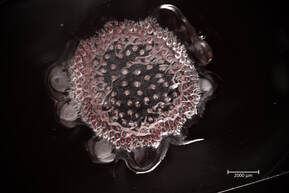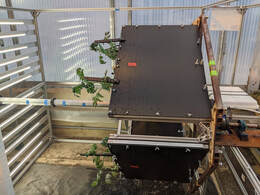Sparks Lab
Overview |
As their name suggests, brace roots are proposed to provide structural integrity and prevent lodging. There is some correlative evidence to support this hypothesis, however the direct contribution of brace roots to structural integrity and what makes a brace root good at that contribution are open questions. In these projects, we aim to define the contribution of brace roots to structural integrity. We are further interested in functional trade-offs between support and the ability to acquire soil resources (water and nutrients). Our work is primarily focused on defining these functions in maize, but we have recently expanded to include sorghum in our research program.
Current Funding
Prior Funding
|
University of Delaware Research Foundation
Thomas Jefferson Fund / FACE Foundation
|
Delaware Biosciences Center for Advanced Technology
|
Brace root contribution to stalk flexural stiffness
In this project, we aim to define the contribution of brace roots to stalk flexural stiffness. The premise of this project is that brace roots function as guy wires to provide structural integrity to the stalk itself. We are using the Device to Assess Lodging IN Grains (DARLING) from our collaborator Dr. Doug Cook at BYU to assess the flexural stiffness in the presence and excision of brace roots. We have applied this approach to 100s of genotypes and 1000s of plants to show that brace roots significantly contribute to stalk flexural stiffness. We are complimenting the empirical data collection with the development of computational models in collaboration with Dr. Christophe Pradal at CIRAD, France.
People working on this project: Lindsay Erndwein, Jon Reneau, & Dr. Ashley Henderson
Collaborators: Dr. Christophe Pradal, Dr. Brian Dilkes, Tecle Weldekidan, & Dr. Doug Cook
Collaborators: Dr. Christophe Pradal, Dr. Brian Dilkes, Tecle Weldekidan, & Dr. Doug Cook
Field-based phenotyping to capture brace root dynamics
Linking with the quantification of the brace root contribution to structural integrity, we are interested in what phenotypes are associated with more or less contribution to flexural stiffness. This requires the development of field-based phenotyping aimed at capturing sub-canopy information. In collaboration with roboticist Dr. Bert Tanner at UD, we have developed ground-based robots that can autonomously navigate the corn field and capture dynamic information.
Quantifying the material properties of brace roots
In addition to the geometry of brace roots, as quantified by phenotyping, the material properties of the roots may also contribute to their function in stability. In this project, we have established 3-point bending methods to quantify the elastic modulus of brace roots, with the ultimate goal of linking the material properties to the brace root contribution to biomechanics.
People working on this project: Lindsay Erndwein
Collaborators: Dr. Megan Killian
Collaborators: Dr. Megan Killian
Functional trade-offs: Supply v. Support
While we are primarily interested in optimizing the function of brace roots in mechanical stability, we do not want to optimize this function at the expense of other functions. Specifically, the main function of roots is to acquire soil resources such as water and nutrients. The capacity for brace roots to uptake nutrients and water compared to other root types has not been explored. Here we aim to define the brace root capacity for nitrogen uptake in mechanical extremes (i.e. brace roots that are highly contributing to mechanical integrity and brace roots that are lowly contributing to mechanical integrity).
People working on this project: Jon Reneau
Collaborators: Dr. Amanda Rasmussen
Collaborators: Dr. Amanda Rasmussen
Building new tools
The role of brace roots in plant biomechanics has been under-explored, which necessitates the development of new, non-destructive tools to measure plant biomechanics. We have worked with an Engineering Senior Design Team to build a greenhouse-based testing platform (The Plant Pusher) to measure biomechanics in greenhouse-grown plants. This platform will expand our testing capabilities and allow us to investigate biotic interactions that we cannot assay in the field. We have additionally designed a Root Spinner for capturing 360-deg images of whole plants, and the Sorghum & Maize Under Rotational Force (SMURF) to assess the contribution of brace roots to anchorage.
People working on this project: Jon Reneau, & Engineering Senior Design
|
Sparks Lab
University of Delaware |
Proudly powered by Weebly

